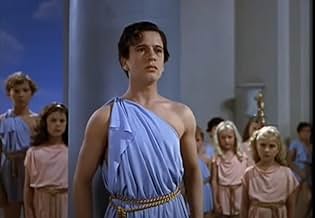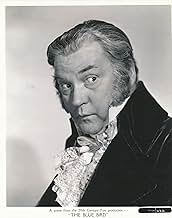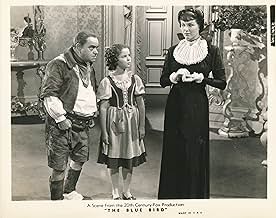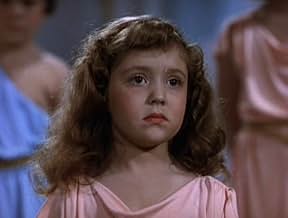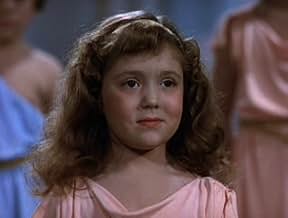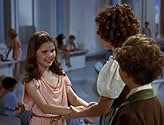Ajouter une intrigue dans votre langueMytyl and her brother Tyltyl, a woodchopper's children, are led by the Fairy Berylune on a magical trip through the past, present, and future to locate the Blue Bird of Happiness.Mytyl and her brother Tyltyl, a woodchopper's children, are led by the Fairy Berylune on a magical trip through the past, present, and future to locate the Blue Bird of Happiness.Mytyl and her brother Tyltyl, a woodchopper's children, are led by the Fairy Berylune on a magical trip through the past, present, and future to locate the Blue Bird of Happiness.
- Réalisation
- Scénario
- Casting principal
- Nommé pour 2 Oscars
- 2 victoires et 2 nominations au total
Avis à la une
Fantasy is the most difficult genre for film to create successfully. All the elements have to come together just right, and then, more often than not, success is a happy accident. Fantasy is not replicable; note the number of failed sequels. If 20th Century Fox was trying to emulate MGM's THE WIZARD OF OZ (an initial box office flop, it should be remembered), it was not a wise endeavor. Given its troubled production history, OZ should have been a disaster. That it was not still puzzles & delights film historians.
THE BLUE BIRD's ultimate failure is not complete. There are several very good things about it. The main trouble seems to be in the casting of Shirley Temple in the lead role. The greatest child star of them all was now aging, and prepubescent Shirley seems to depend a bit too much on the gracious memories of her devotees. She's still cute, but this time that's just not enough. Also, it must have been awkward acting such a nasty role, one doomed to be disliked by the audience for much of the film.
Gale Sondergaard, as the Cat, has much the same problem. She tries hard, but the role is very unsympathetic & we are never told why her character is so wicked - indeed, capable of murder.
It's interesting to note that both Temple & Sondergaard were important contenders for major roles in OZ, but were instead rejected for Judy Garland & Margaret Hamilton.
There are several cast members that do an excellent job with their material: Spring Byington, tender as Shirley's mother; wonderful old Jessie Ralph as the fairy; Eddie Collins, often very funny as the Dog; Nigel Bruce & Laura Hope Crews, giving ripe performances as Mister & Mrs. Luxury; and dear Cecilia Loftus & Al Shean as Shirley's lonely, dead grandparents.
Some of the minor casting is also very effective, witness Thurston Hall as Father Time, Edwin Maxwell as Old Man Oak & Sterling Holloway, on screen only a few seconds as Wild Plum. That's Scotty Beckett, from the old OUR GANG Comedies, as one of the Unborn Boys.
The use of Technicolor is very eye-appealing, although its initial entry into the film lacks the dramatic punch produced in OZ. The forest firestorm sequence is very well done & the Unborn Children scenes have genuine pathos.
This was a famous flop, and ended the unbroken string of hits for Miss Temple. Because victory has a thousand fathers, but defeat is an orphan, everyone seems to have an explanation of why it failed out the box office. Miss Temple was aging out of her cute moppet appeal. It was overproduced, and the focus was on the Technicolor and fantastic sets. War in Europe made people impatient with the allegory. The movie's director, Walter Lang, blamed it on bad editing.
My explanation is a lot simpler: it lacks any sense of fun. It's all obvious allegory that is hammered into the audience's head like they are stupid. Miss Temple starts out as an unpleasant girl, and only gradually becomes nice. She doesn't dance, her singing is limited to one song. Her problems aren't real, so her overcoming them is muted in effect.
Maurice Maeterlinck's play may have been a triumph, but it was a triumph of spectacle. Spectacle can make a movie, but without any sense of engagement, it's empty. This movie is quite beautiful, in a visual sense, but its story telling, its message is mechanical an uninvolving.
Interesting as well because the rumors had it that Darryl Zanuck saw the big money that The Wizard Of Oz made over at MGM with Judy Garland and decided this was action he wanted 20th Century Fox in. So he shot the works financially and the famous Maeterlinck story The Blue Bird was adopted for Shirley Temple.
The Blue Bird is a symbol for good luck and prosperity and one that Shirley and little brother Johnny Russell had has disappeared. A magical fairy played by Jessie Ralph sends them on a journey into an Oz like land with their animated pets, Eddie Collins as their dog and Gale Sondergaard as the cat. Sondergaard is truly interesting, she plays the animated cat like she was being the Spiderwoman and really acts like a fifth columnist for the kids.
The story even resolves itself like the Wizard Of Oz.
The Blue Bird got Oscar nominations for Special Effects, but lost to Alexander Korda's The Thief of Bagdad.
It never came close to raking in its cost for 20th Century Fox. It was the end of Shirley Temple as a child star. Ironically MGM had wanted her for The Wizard Of Oz, but Zanuck wouldn't let her go. It was then they signed Judy Garland who cost L.B.Mayer not a dime as she was under contract.
Seeing it today it's an interesting children's fantasy and may have not gotten the praise it deserved back in the day.
Black and White prologue: Set on Christmas Eve in a little German town sometime in the 19th Century, Mytyl Tyl (Shirley Temple), and her little brother, Tyltyl (Johnny Russell) at the Royal Forest are introduced trapping a rare little bird into a cage. On the way home, Mytyl is called over by Angela Berlinger (Sybil Jason), a sickly child resting by her bedroom window, if she would be interested in trading the bird with one of her possessions, but is refused. Aside from Angela's mother (Leona Roberts) who labels Myrtyl as a selfish child, so do her parents (Russell Hicks and Spring Byington), which explains why Mytyl is never very happy. Problems soon arise for the family when Mytyl's woodcutting father is called to war and to report Christmas day. As the children go to bed for the night, (shift to Technicolor) they each dream of themselves searching for the Blue Bird of Happiness, thus, meeting with numerous characters to guide them: Fairy Berylune (Jessie Ralph), Light (Helen Ericson), their dog and cat, Tylo and Tylette (Eddie Collins and Gale Sondergaard), magically changed to human form. While going through many aspects of human experience, Mytyl and Tyltyl visit the past, going to the land of memories in the cemetery where they are briefly reunited with their deceased grandparents (Al Shean and Cecilia Loftus); living the life of richness in the mansion of Mr. and Mrs. Luxury (Nigel Bruce and Laura Hope Crews); roaming through the forest where danger awaits, with uprooted trees and blazing fire; and moving into the future where the children visit the Palace of the Unborn where they make the acquaintance of children awaiting to be born before finding their destinies on Earth - but still no finding of the blue bird of happiness. Upon their awakening, further events await them. (While it would be asking too much to accept two children to be having the exact same dream while sleeping, but considering this to be a fantasy, it's possible acceptance to the viewer).
Other members of the cast are Thurston Hall (Father Time); Sterling Holloway (Wild Plum Tree); and possibly every child actor in the movie business appearing briefly as Gene Reynolds; Ann E. Todd, Scotty Beckett, Billy Cook, Diane Fisher, among others. Johnny Russell, the doll-faced little boy has that rare distinction of having and sharing equal time with Temple, while the lesser known name of Helen Ericson as Light stands out as a sort of glowing guardian dressed in white angel with that Heavenly glow.
First produced as a stage play, then adapted as a silent movie (Paramount, 1918), and much later retold again (20th Century-Fox, 1976) directed by George Cukor, regardless of its negative reputation, it's the 1940 edition that's become the best known of the three due to frequent television broadcasts starting in the late 1960s, usually around the Christmas season. Though there are those who claim this BLUE BIRD has laid an egg, overlooking some dull passages, it does contain some fine moments of honorable mention: lavish scale settings with crisp, glossy Technicolor; the beautiful yet haunting score to "Through the World so Far Away" sung by children on with giant ship with the golden sail on their way to be born, this being one of the longer dream segments of the dream; and one with an important message. Reportedly consisting of occasional song numbers, all except one, "Lay Dee O," sung and danced by Shirley Temple to her grandparents, remains in final cut. In fact, this is one of the few instances where the film comes to life, being a sheer reminder of formula Temple cheerfulness. Eddie Collins adds occasional humor as the humanly frightful dog while Gale Sondergaard adds tastes of cat-eye wickedness, but no threat to Margaret Hamilton's scene stealing Wicked Witch of the West from THE WIZARD OF OZ.
Formerly available as part of the Shirley Temple Playhouse on video cassette in 1989, and later in DVD format, THE BLUE BIRD has turned up on numerous cable channels over the years, ranging from The Disney Channel (1980s), American Movie Classics (1996-2001), Fox Movie Channel, and finally Turner Classic Movies (TCM premiere: December 20, 2015). With the reportedly heavy editing of songs and scenes to abide to Temple's attention throughout, it's a wonder how THE BLUE BIRD might have turned out theatrically in completed form of more musical sequences as opposed to its 83 minute release of the blue bird search for happiness? Whether it would have made a difference between success and failure is anybody's guess. (***1/2)
Le saviez-vous
- AnecdotesThe blue bird of the title was paid $50 a day, and flew away from a Los Angeles aviary soon after the movie was finished.
- Citations
Granny Tyl: Somebody must be thinking of us. I feel quite strong. I think we're going to have visitors. They seem to be coming near.
Grandpa Tyl: Maybe now I can finish my carving. I've been at this one for nearly a whole year.
Granny Tyl: That's because we're so seldom awake.
Mytyl, Tyltyl: Granny! Grandpa!
Granny Tyl: It's the children! Give us a hug, dears, a big one this time.
Grandpa Tyl: It's been months and months since you last remembered us.
Granny Tyl: The last time was Easter morning. The church bells were ringing.
Mytyl: Easter? Oh, we didn't go out that day. We both had very bad colds.
Granny Tyl: But you thought of us.
Mytyl: Yes, we missed you.
Granny Tyl: Every time you think of us, we wake up and see you again.
Mytyl: But we thought you were dead.
Granny Tyl: No, dear. Only when we're forgotten.
- Crédits fousOpening credits listed in hand turned pages of a book.
- ConnexionsFeatured in Biography: Shirley Temple: The Biggest Little Star (1996)
Meilleurs choix
- How long is The Blue Bird?Alimenté par Alexa
Détails
- Date de sortie
- Pays d’origine
- Langue
- Aussi connu sous le nom de
- The Blue Bird
- Lieux de tournage
- Société de production
- Voir plus de crédits d'entreprise sur IMDbPro
Box-office
- Budget
- 2 000 000 $US (estimé)
- Durée
- 1h 28min(88 min)
- Rapport de forme
- 1.37 : 1

